|
|
|
Sort Order |
|
|
|
Items / Page
|
|
|
|
|
|
|
| Srl | Item |
| 1 |
ID:
099231
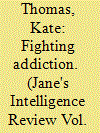

|
|
|
| 2 |
ID:
154046


|
|
|
|
|
| Summary/Abstract |
Europe has a strong interest in and a history of assisting Iran in controlling inflows of drugs from Afghanistan. But due to Iran’s increasing use of the death penalty in drug trafficking cases, Europe has terminated its cooperation. Based on interviews with Iranian policy-makers and representatives of both human rights organizations and the United Nations Office on Drugs and Crime (UNODC), this article presents Denmark’s withdrawal of drug control funding in 2013 as a case study, analyzing the dilemmas and trajectories of joint Iranian-European drug diplomacy and the prospects for reengagement following the nuclear agreement.
|
|
|
|
|
|
|
|
|
|
|
|
|
|
|
|
| 3 |
ID:
164213


|
|
|
|
|
| Summary/Abstract |
THE DELIBERATE DESTRUCTION of architectural monuments and works of art has a history that runs into millennia. The ravaging of Rome by the Gauls in 390 B.C., the demolition of churches during the 17th-century civil war in England, the methodical bombing of historic buildings during World War II, the destruction of cultural monuments in northern Cyprus after the Turkish invasion of it in 1974, the 1991 bombardment of the old part of Dubrovnik, a city that the United Nations Educational, Scientific and Cultural Organization (UNESCO) has had on its World Heritage list since 1979, the smashing by the Taliban of two giant statues of Buddha in Afghanistan's Bamyan mountains in 2001, looting and illegal archaeological excavations in Iraq after 2003, and the destruction of cultural objects by Islamic State (ISIS) in Iraq, Syria and Libya1 are just a few examples of the outrages that have deprived world civilization of cultural gems and have supplied the black market with antiquities.
|
|
|
|
|
|
|
|
|
|
|
|
|
|
|
|
| 4 |
ID:
086189
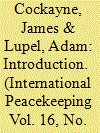

|
|
|
|
|
| Publication |
2009.
|
| Summary/Abstract |
Peace operations are increasingly on the front line in the international community's fight against organized crime. In venues as diverse as Afghanistan, the Balkans, Haiti, Iraq and West Africa, multiple international interventions have struggled with a variety of protection rackets, corruption and trafficking in a wide range of licit and illicit commodities: guns, drugs, oil, cars, diamonds, timber - and human beings. This introduction to the Special Issue on peace operations and organized crime discusses the concept of 'organized crime' as a label, and suggests ways of differentiating organized crime groups on the basis of their social governance roles, resources and strategies towards authority structures - such as peace operations.
|
|
|
|
|
|
|
|
|
|
|
|
|
|
|
|
| 5 |
ID:
146383


|
|
|
| 6 |
ID:
132047
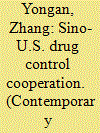

|
|
|
|
|
| Publication |
2014.
|
| Summary/Abstract |
Asia's Golden Triangle and Golden Crescent are two of the world's largest drug-producing areas. They make about 90% of the world's opium-Afghanistan alone accounts for about 74% 0.012).' lllicit drugs
production and tra?ieking in Asia pose a serious threat to China and the U.S.. In recent years, China and the U.S. have been working closer to deal with this threat. Their cooperation, however, has not always been smooth. The Threats as drug production in Asia rises steadily, the number of types of drugs increases, and with globalization and a growing consumer society, international drug trafficking routes targeting China and U.S. markets have become more complicated. The threats to both countries have also grown. First, although opium poppy cultivation in the Golden Triangle has been declining in recent years, it still poses a threat in the 1ong-tcrm because of its large base. According to a report issued by United Nations Office on Drugs and Crime (UNODC), in 2011 poppy plantations covered 51,000
|
|
|
|
|
|
|
|
|
|
|
|
|
|
|
|
| 7 |
ID:
183949


|
|
|
|
|
| Summary/Abstract |
Since the late twentieth century, two United Nations organizations have monitored the global trade in drugs from their respective perches in Geneva: the Essential Drugs Program of the World Health Organization (WHO) and the United Nations Office on Drugs and Crime (UNODC). In 1988, the Essential Drugs Program published the first edition of the World Drug Situation, which narrates the many barriers preventing “essential” drugs (antibiotics, anti-epileptics, insulin, etc.) from successfully travelling from centers of production in the global North to arenas of potential consumption in the global South. The UNODC’s annual World Drug Report figures the opposite problem by policing “non-medical” drugs that are trafficked from centers of production in the global South to illicit consumer markets, some of the largest of which are in the global North.
|
|
|
|
|
|
|
|
|
|
|
|
|
|
|
|
| 8 |
ID:
104254
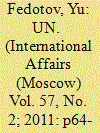

|
|
|
|
|
| Publication |
2011.
|
| Summary/Abstract |
Armen Oganesyan, Editor-in-Chief of International Affairs: When one decides to take charge of as important an organization as the UN Office on Drugs and Crime (UNODC), they draw up an action plan and decide on their priorities. Which goals did you set yourself and which of them are top priority?
Yuri Fedotov: I am currently the head of the UN Office on Drugs and Crime while being also in charge of the UN office in Vienna to coordinate the operation of several international organizations (the UN Office for Outer Space Affairs, UNCITRAL, etc.).
|
|
|
|
|
|
|
|
|
|
|
|
|
|
|
|
| 9 |
ID:
126225
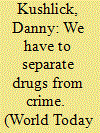

|
|
|
|
|
| Publication |
2012.
|
| Summary/Abstract |
It is time to consider all alternative options, argues
|
|
|
|
|
|
|
|
|
|
|
|
|
|
|
|
|
|
|
|
|